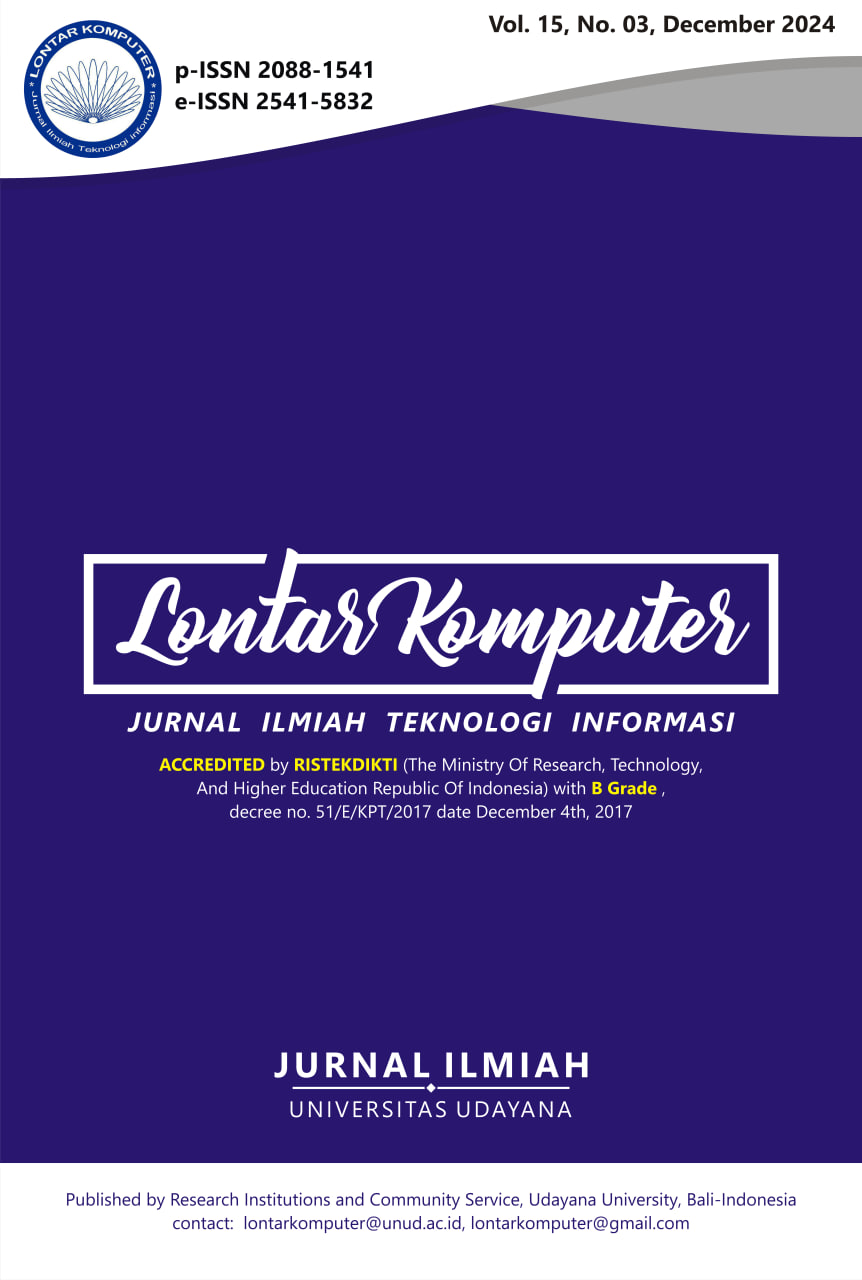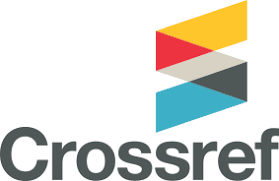Training VGG16, MobileNetV1 and Simple CNN Models from Scratch for Balinese Inscription Recognition
Abstract
Many inscriptions in Bali are damaged. Damage to these inscriptions can be caused by natural disasters, overgrown with moss, algae and bacteria. Damage can also be caused by warfare, or deliberately erased. This inscription contains the knowledge and civilization of the ancestors so it is very important to be able to read its contents. Based on these problems, this research conducted training from scratch on 3 CNN models namely VGG16, MobileNetV1 and Simple CNN. The purpose of this research is to choose one recognition model that has the best performance and produces the highest recognition rate to proceed to the inscription restoration stage. The dataset used is Balinese inscription: Isolated Character Recognition of Balinese Script in Palm Leaf Manuscript Images in Challenge-3-ForTrain.zip. The training process of three models with five different training files resulted in the finding that VGG16 has the highest accuracy in the training, testing, and validation process with the least number of epochs. This research contributes to specific datasets, such as the Isolated Character Recognition of Balinese Script using the training process from the beginning of VGG16, involving all stages of the process. It will produce the best model performance compared to the other four training models.
Downloads
References
[2] G. A. Sambodo, Y. K. Suprapto, and E. M. Yuniarno, “Application of Photogrammetry Techniques in Reconstructing the Carving on Stone Inscriptions,” Berk. Arkeol., vol. 40, no. 2, pp. 309–328, 2020, doi: 10.30883/jba.v40i2.597.
[3] I. N. Sunarya, I. G. M. Suarbhawa, and I. W. Sumerata, “Penelitian Prasasti Kintamani,” Denpasar, 2015.
[4] H. Prihatmoko, “Kajian Epigrafis Prasasti Babahan,” Forum Arkeol., vol. 29, no. 3, p. 117, 2017, doi: 10.24832/fa.v29i3.100.
[5] I. W. A. S. Darma, “Implementation of Zoning and K-Nearest Neighbor in Character Recognition of Wrésastra Script,” Lontar Komput. J. Ilm. Teknol. Inf., vol. 10, no. 1, p. 9, 2019, doi: 10.24843/lkjiti.2019.v10.i01.p02.
[6] G. Indrawan, A. Asroni, L. Joni Erawati Dewi, I. G. A. Gunadi, and I. K. Paramarta, “Balinese Script Recognition Using Tesseract Mobile Framework,” Lontar Komput. J. Ilm. Teknol. Inf., vol. 13, no. 3, p. 160, 2022, doi: 10.24843/lkjiti.2022.v13.i03.p03.
[7] E. Paulus, S. Hadi, M. Suryani, I. Suryana, and Y. D. Simanjuntak, “Evaluating Ancient Sundanese Glyph Recognition Using Convolutional Neural Network,” J. Phys. Conf. Ser., vol. 1235, no. 1, 2019, doi: 10.1088/1742-6596/1235/1/012063.
[8] A. A. Hidayat, K. Purwandari, T. W. Cenggoro, and B. Pardamean, “A Convolutional Neural Network-based Ancient Sundanese Character Classifier with Data Augmentation,” Procedia Comput. Sci., vol. 179, no. 2020, pp. 195–201, 2021, doi: 10.1016/j.procs.2020.12.025.
[9] B. J. Bipin Nair, K. V. Aadith Raj, M. Kedar, S. P. Vaishak, and E. V. Sreejil, “Ancient Epic Manuscript Binarization and Classification Using False Color Spectralization and VGG-16 Model,” Procedia Comput. Sci., vol. 218, pp. 631–643, 2022, doi: 10.1016/j.procs.2023.01.045.
[10] J. Ravi, “Handwritten alphabet classification in Tamil language using convolution neural network,” Int. J. Cogn. Comput. Eng., vol. 5, no. April 2023, pp. 132–139, 2024, doi: 10.1016/j.ijcce.2024.03.001.
[11] M. W. A. Kesiman, S. Prum, J. C. Burie, and J. M. Ogier, “Study on feature extraction methods for character recognition of Balinese script on palm leaf manuscript images,” Proc. - Int. Conf. Pattern Recognit., vol. 0, pp. 4017–4022, 2016, doi: 10.1109/ICPR.2016.7900262.
[12] M. Avadesh and N. Goyal, “Optical character recognition for sanskrit using convolution neural networks,” Proc. - 13th IAPR Int. Work. Doc. Anal. Syst. DAS 2018, pp. 447–452, 2018, doi: 10.1109/DAS.2018.50.
[13] N. P. Sutramiani, N. Suciati, and D. Siahaan, “MAT-AGCA: Multi Augmentation Technique on small dataset for Balinese character recognition using Convolutional Neural Network,” ICT Express, vol. 7, no. 4, pp. 521–529, 2021, doi: 10.1016/j.icte.2021.04.005.
[14] I. P. B. G. Prasetyo Raharja, I. M. Suwija Putra, and T. Le, “Kekarangan Balinese Carving Classification Using Gabor Convolutional Neural Network,” Lontar Komput. J. Ilm. Teknol. Inf., vol. 13, no. 1, p. 1, 2022, doi: 10.24843/lkjiti.2022.v13.i01.p01.
[15] T. Septianto, E. Setyati, and J. Santoso, “Model CNN LeNet dalam Rekognisi Angka Tahun pada Prasasti Peninggalan Kerajaan Majapahit,” J. Teknol. dan Sist. Komput., vol. 6, no. 3, pp. 106–109, 2018, doi: 10.14710/jtsiskom.6.3.2018.106-109.
[16] O. Sudana, I. W. Gunaya, and I. K. G. D. Putra, “Handwriting identification using deep convolutional neural network method,” Telkomnika (Telecommunication Comput. Electron. Control., vol. 18, no. 4, pp. 1934–1941, 2020, doi: 10.12928/TELKOMNIKA.V18I4.14864.
[17] M. W. A. Kesiman et al., “AMADI _ LontarSet : The First Handwritten Balinese Palm Leaf Manuscripts Dataset,” in 15th International Conference on Frontiers in Handwriting Recognition, 2016, pp. 168–173, doi: 10.1109/ICFHR.2016.39.
[18] M. Juez-Gil, Á. Arnaiz-González, J. J. Rodríguez, C. López-Nozal, and C. García-Osorio, “Approx-SMOTE: Fast SMOTE for Big Data on Apache Spark,” Neurocomputing, vol. 464, pp. 432–437, 2021, doi: 10.1016/j.neucom.2021.08.086.
[19] Narayanan and Jayashree, “Implementation of Efficient Machine Learning Techniques for Prediction of Cardiac Disease using SMOTE,” Procedia Comput. Sci., vol. 233, no. 2023, pp. 558–569, 2024, doi: 10.1016/j.procs.2024.03.245.
[20] Y. Lu et al., “Influence of the parameters of the convolutional neural network model in predicting the effective compressive modulus of porous structure,” Front. Bioeng. Biotechnol., vol. 10, no. September, pp. 1–11, 2022, doi: 10.3389/fbioe.2022.985688.

This work is licensed under a Creative Commons Attribution 4.0 International License.
The Authors submitting a manuscript do so on the understanding that if accepted for publication, the copyright of the article shall be assigned to Jurnal Lontar Komputer as the publisher of the journal. Copyright encompasses exclusive rights to reproduce and deliver the article in all forms and media, as well as translations. The reproduction of any part of this journal (printed or online) will be allowed only with written permission from Jurnal Lontar Komputer. The Editorial Board of Jurnal Lontar Komputer makes every effort to ensure that no wrong or misleading data, opinions, or statements be published in the journal.
 This work is licensed under a Creative Commons Attribution 4.0 International License.
This work is licensed under a Creative Commons Attribution 4.0 International License.























